“A Room with Snoopy”—Reversing Tatzu Nishi’s A Room of Hachi
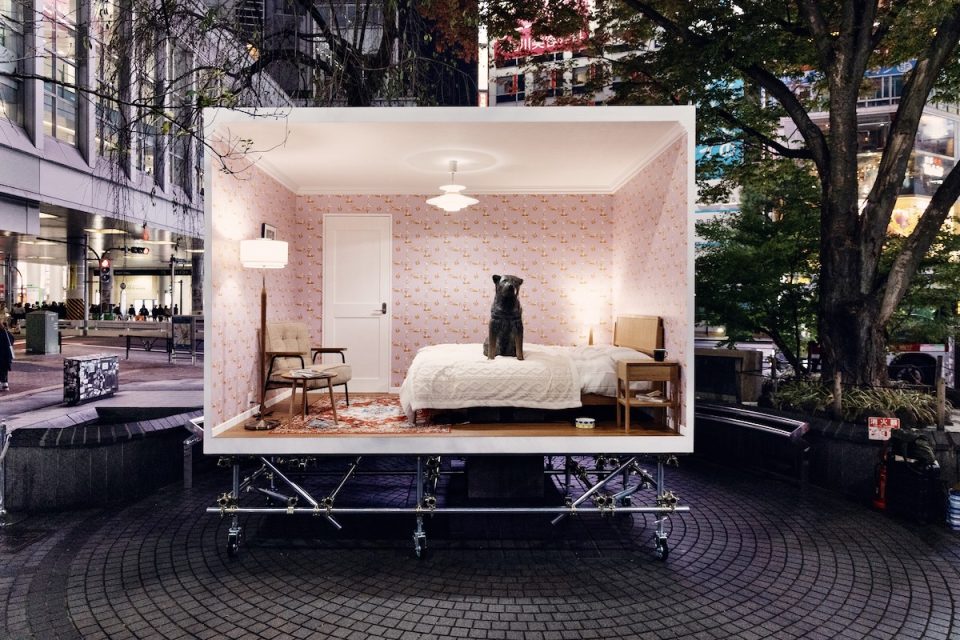
Tatzu Nishi – A Room of Hachi (2023), Hachiko Square, Shibuya, Tokyo.
All photos (except where otherwise noted): 88PROJECTS/Jiroh Fujimura. ©︎Tatzu Nishi, courtesy 88PROJECTS
After writing about the statue of Hachiko at Shibuya Station in the previous instalment of this column, I learned that on the last day of the 15th Shibuya Art Scramble festival, November 12, artist Tatzu Nishi staged an art project titled A Room of Hachi that made use of the statue for just 24 hours. As mentioned last time, this year (2023) is the 100th anniversary of Hachiko’s birth. In this momentous year, one could say that Nishi’s transformation of the statue of Hachiko into an artwork was itself a unique occasion. Partly for this reason, as not a sequel but an “additional episode,” so to speak, I have decided to deal with the transformation of the statue of Hachiko again this time. In fact, it is fortunate that at the end of my previous column I touched on the reproducible and pluralistic characteristics of the statue. In addition, I presented Nishi’s transformation of the statue of Hachiko as a subject for discussion at the seminar I am in charge of at Tama Art University, and had a student who went to see it give a presentation, and after soliciting everyone’s opinions, a range of interpretations came to light.
Nishi’s project—which involved covering the pedestal of the statue of Hachiko and surrounding it with a room-like box, with only the front side open—envisioned transforming the statue of Hachiko, a public sculpture, into an indoor work. However, given that the statue is extremely popular, plus a symbol of Shibuya, it seems that achieving this (let alone turning it into an accommodation facility, Nishi’s specialty) was difficult, even for just one day, and in this respect it differed from Nishi’s projects to date. Still, surrounding it with a roof and floor and with walls on three sides (left, right, and back) meant that the statue of Hachiko was only visible from the front, and to the extent that only people standing there could “confront” the statue, though it remained a public sculpture, the proprietary nature of the viewing experience was dramatically enhanced. In fact, as a result of this transformation, partly because it only lasted one day but also because it was a Sunday, a long line of people wanting to take “private” commemorative photos formed in front of the statue, with people reportedly having to wait 30 minutes for their turn.
Be that as it may, looking at the photographs the student presented at my seminar, what struck me first was not the physical transformation of the statue itself, but why the room in which Hachiko sat was Western-style instead of a Japanese. Incidentally, Nishi has commented as follows regarding this project:
The statue of Hachiko has stood in front of Shibuya Station since 1934. Hachiko has continued to sit there even on rainy or snowy days for around 90 years. Building a room will result in an artwork related to the 100th anniversary of Hachiko’s birth with the message, “Have a rest indoors, Hachiko. Thanks for all your hard work.” The artistic theme is the same as all my other works: “the expansion of the human imagination.” (1)
Here, while establishing “Thanks for all your hard work over 100 years” as the official reason for using the statue of Hachiko as material for his own art on the 100th anniversary of Hachiko’s birth, at the same time Nishi states plainly that the theme running through his own work, “the expansion of the human imagination,” was also assumed. Thus this project was meaningful to the extent that a public “within expectation” and a private “beyond expectation” were being pursued simultaneously. With this in mind, in my seminar, based on the visual characteristics of this project, I decided to test the expansion of the imagination to its limits. What emerged was the following question: Just “whose” room is “Hachiko’s Room”?
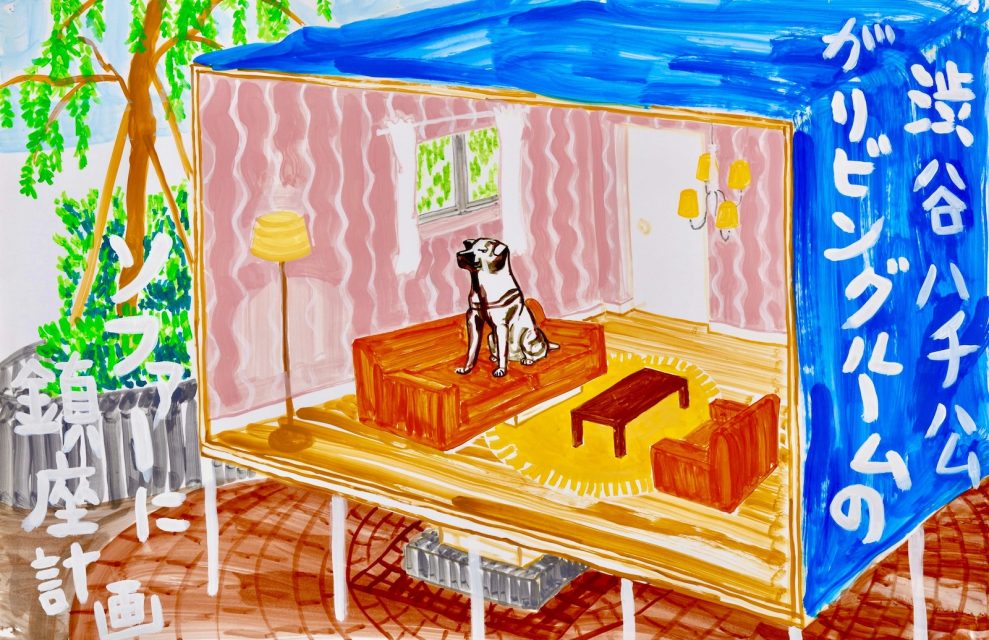
Tatzu Nishi – Hachiko Project (2009), acrylic on paper, 65 x 100 cm. ©︎Tatzu Nishi, courtesy ANOMALY.
To being with, though it is so obvious it may escape the notice of viewers, Nishi’s A Room of Hachi is not “A Room that Hachiko Owns” or “A Room where Hachiko Lives.” As far as one can tell by looking at the individual components, all the furniture that makes up the room is for humans, and (with the possible exception of the water bowl) there is no dog furniture. Of course, there is nothing wrong with a dog using furniture designed for humans, but by looking at the slippers placed on the floor and the casually placed magazines and books, there are clearly signs of a human in the room in addition to the statue of Hachiko. In other words, “Hachiko’s Room” is also “someone” else’s room. And so, at my seminar, I decided to discuss with my students the question, “Just whose room is this?”
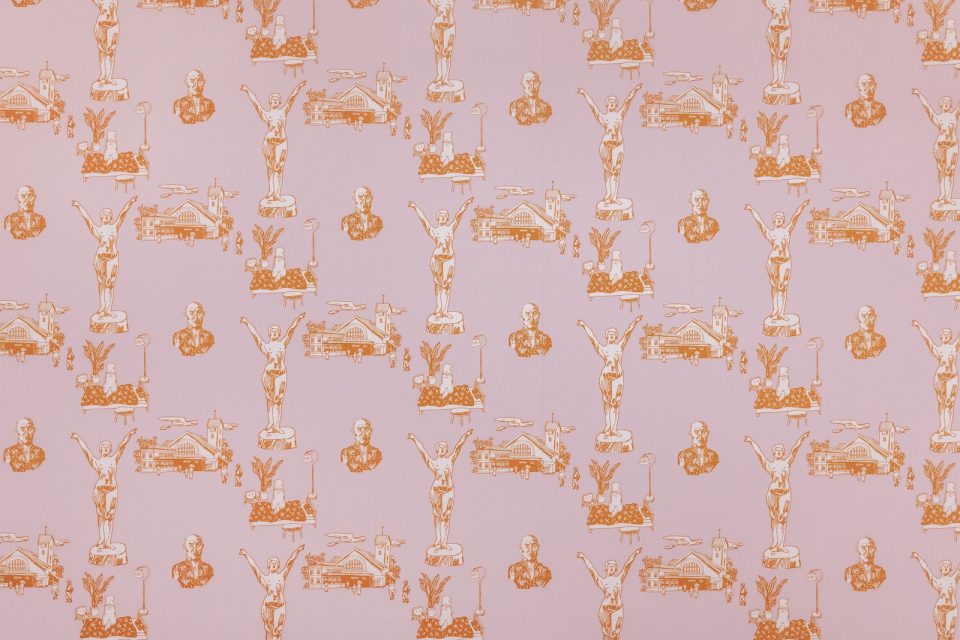
Tatzu Nishi – A Room of Hachi wallpaper.
The first clue to answering this question is the wallpaper. Upon enlarging it, we discovered that it has a pattern made up of four illustrations. The first is a portrait of Hachiko’s owner, Professor Ueno. The second is an illustration of Shibuya Station as it appeared in 1923 when Hachiko went to meet Professor Ueno every day. The third is an image of Ozora ni (To the sky), the statue of a nude woman made by the artist responsible for creating the original statue of Hachiko, Teru Ando (in fact, his most famous work), which Teru’s son, Takeshi, had melted down to provide the bronze with which he made the current statue of Hachiko (after issuing an “apology” to his father, who by this time had already died in an air raid) after the first statue was dismantled during the war under the system of obligatory supplies of goods to the government for military purposes (the Metals Recovery Ordinance). And the final image is of Hachiko himself sitting on a low bed with his back to the viewer as he gazes at the other three images closely associated with his own history (and perhaps looks back over the past 100 years?).
But Hachiko was born in the Taisho period. So why is he sitting not in a garden or an earthen-floored room, or even on a futon laid out in a Japanese-style room, but on a bed? Apparently this is related to the anecdote according to which Professor Ueno, noticing that the newly born Hachiko was physically exhausted and extremely weary after the 20-hour journey from Odate, Akita, to Shibuya, allowed him to rest on his own bed. Given Ueno’s status as a professor at the University of Tokyo at a time when people liked to dress in the latest Western fashion, this seems perfectly understandable.
So, does that mean this room is Professor Ueno’s? Well, the answer is no. Even if he had a preference for Western-style things, the fashion and design magazines [upon viewing the on-line “making-of” video, I was able to confirm that one of them was Casa BRUTUS (2)], and the two books—one relating to prayers for better luck and the other to improving one’s health—placed casually around the room (the covers of the magazines and books are hidden so the details are unclear) are too contemporary and light to have been used as bedside reading by Professor Ueno, who was anxious about his health.
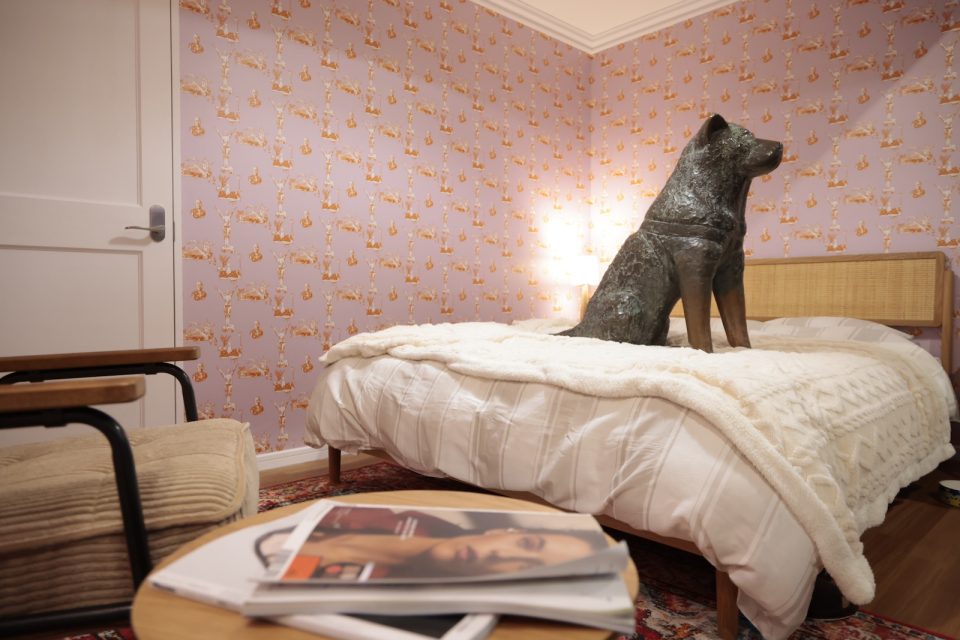
Tatzu Nishi – A Room of Hachi (2023), Hachiko Square, Shibuya, Tokyo.
The second clue is that the furniture and furnishings in “Hachiko’s Room” seem somehow fancy. Upon asking my students for their opinions on where this feeling came from, it became apparent that the furniture in “Hachiko’s House” was provided by the mail-order and online shopping business Belle Maison. (3) So what are the connections between Hachiko and Belle Maison? Given that the artist is Tatzu Nishi, it is difficult to imagine that he accepted as is whatever furniture happened to be provided. Certainly, as Nishi states, Belle Maison provides the kind of furniture that is perfect for “extremely ordinary living rooms and bedrooms.” However, as Nishi also states, this was an opportunity for the “expansion of the human imagination.” Clearly, we need to explore this further.
The first thing to consider is that Belle Maison furniture may certainly be “extremely ordinary” for us. But what about for Hachiko? After all, Hachiko is a Taisho-period dog. What if we think about it the other way around. What kind of dog would suit a room made up of Belle Maison furniture? Upon checking the Belle Maison website, I noticed at the bottom of the menu screen the headings “Disney” and “Characters,” (4) and when I clicked on the latter, I was surprised to see who was at the top, ahead of Moomin and Doraemon: it was that popular American-born dog character, Snoopy.
As if that were not already enough, upon “expanding my imagination” even further and clicking on the link, I came across a product image showing Snoopy relaxing on a bed and appliques with a scene of Snoopy reading a book with a blue cover design (one of the books in “Hachiko’s Room” also had a blue cover). (5) Did this mean that the room’s resident was an American, or a Japanese who admired American things (based on the Belle Maison images, the latter seemed more likely), perhaps a female Snoopy fan who paid attention to her health and fortune and enjoyed reading light culture magazines in her bedroom every day?
Why a woman? Of course, one cannot say this based solely on the color of the wallpaper and the somewhat fancy taste in furniture. Because it goes without saying that people of other genders have such taste. The reason I still surmise the room’s resident is a woman is because Belle Maison’s parent company, Senshukai Co., Ltd., itself touts “Women’s Smiles Company” as its corporate vision, and states expressly that “Senshukai has consistently developed businesses intimately connected to women’s various life stages, such as employment, marriage, childbirth, childrearing and self-improvement, providing products and services that bring smiles to customers’ faces” (underlining added). (6)
Based on the above, then, we can say that “Hachiko’s Room” as made up by Tatzu Nishi is a Japanese woman’s room. Exactly when did Hachiko’s owner become a woman? But what if the dog she owned were not the somewhat “chunky” Hachiko, but the fancy and lovable Snoopy? I get the feeling the furnishings in Nishi’s room are suited not to the statue of Hachiko, but to Snoopy himself. In fact, as indicated by the fact that Belle Maison places him at the top of their list of character goods, it would probably not be an exaggeration to say that the most successful dog in the character business that grew rapidly in post-war Japanese society, which achieved both peace and rapid economic growth, was Snoopy. But would the statue of Hachiko actually be relaxing after “all his work over 100 years” in a room perfect for Snoopy to relax in, or “Snoopy’s Room,” as it were? Actually, he probably would.
Because while Hachiko himself may have been born 100 years ago, the statue of Hachiko was completed in 1934, and as mentioned above, this first statue was requisitioned by the government during the war and melted down. The statue of Hachiko that stands in front of Shibuya Station today is a different statue completed in 1948. In other words, the second statue of Hachiko is a child of the post-war democratic society. That being the case, it would be no surprise if instead of being a “faithful dog,” he would have had a freedom-loving disposition (even though he was a pet dog). Moreover, there is also a theory that it was GHQ that initially moved to have the second statue of Hachiko built.
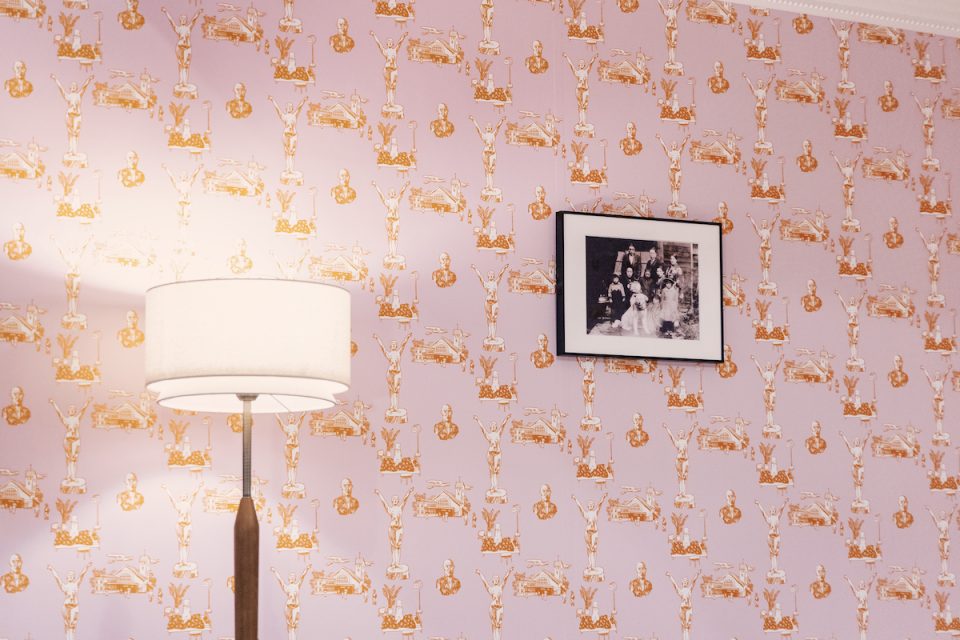
Tatzu Nishi – A Room of Hachi (2023), Hachiko Square, Shibuya, Tokyo.
Taking all the above into account, it is clear that Tatzu Nishi’s A Room of Hachi is far more complex than it first appears. Nishi’s project, which arose from the “ordinary” worldview of loving America’s favorite pet dog, Snoopy, held by the people of a defeated nation who came to regard as absolute the values of a victorious nation (the US) in place of feudalism and strived for economic growth, is at once a “reversed” self-portrait of the “faithful dog” Hachiko and in fact a reflection of the likeness of each one of us. And while it seems that with this project we are looking at the statue of Hachiko relaxing on a bed, in fact we are also exposed to Hachiko’s gaze. And just what is it that we can see from the perspective of the statue of Hachiko following its move indoors? Surely the “scene of the ‘faithful dog’ Hachiko” is Hachiko gazing intently without a break at the ever-changing scenery of Shibuya Station since the construction of the second statue. And on the wall of A Room of Hachi that directly faces this “scene of Hachiko” has been hung a photograph showing Japanese people as they once appeared surrounding Hachiko (not the statue of Hachiko) to console the soul of bygone Japan, this alone in black and white as if it were a portrait of a deceased person.
Postscript: The content of this column derives in large part from a presentation and discussion held at the Contemporary Art Seminar at Tama Art University. I am grateful for the positive contributions of the seminar students.
A Room of Hachi was on public view from 8am to 10pm, November 12, 2023, as a part of the 15th Shibuya Art Scramble festival.http://shibuyaartscramble.tokyo/
“Nishino Tatsu, <Hachikō no heya> ga dekiru made (Tokyo Shibuya). 2023-nen 11-gatsu 12-nichi mimei kara shūtingu.” [Until Tatzu Nishi’s A Room of Hachi was completed (Shibuya, Tokyo). Shot from before dawn on November 12, 2023.], Casa BRUTUS.
https://youtu.be/6OObARl0ixU
https://prtimes.jp/main/html/rd/p/000000169.000013288.html
https://www.bellemaison.jp/shop/commodity/0000/1236996?SHNCRTTKKRO_KBN=CT&CLICKLOG=27
